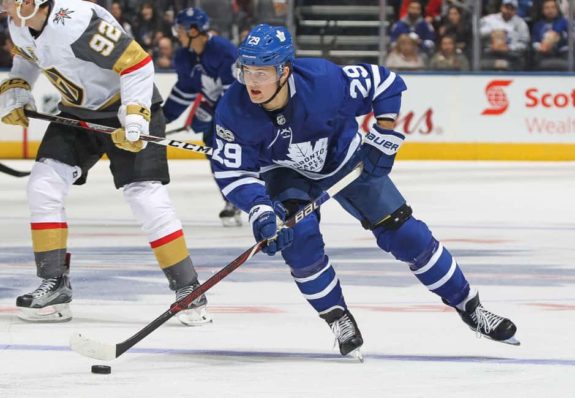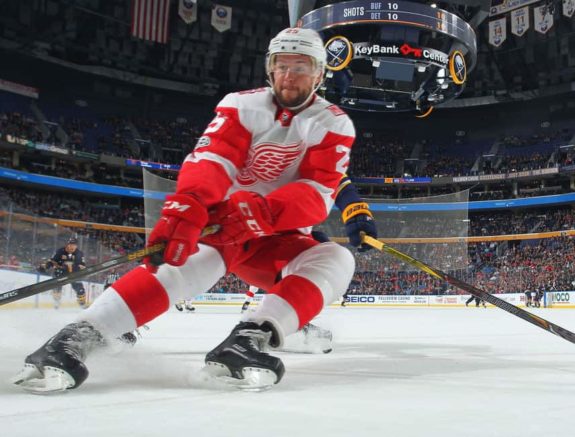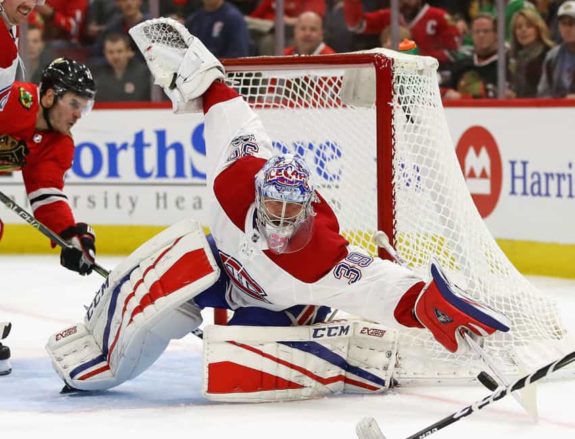I have been playing fantasy hockey for my whole life and I have done fairly well. Well enough that for a couple of years, none of my friends would play with me. Still, don’t let the title fool you – I am no expert. A fantasy expert has only one job, and that is pouring over data and learning everything there is learn about hockey, hockey pools and the NHL.
I am a hockey pool enthusiast.
If you want standard expert advice, the internet is filled with it. This is food for thought for anyone considering some advanced strategy in order to neutralize the power of luck and the availability of information. One thing I have noticed in the last few years is that hockey pools have become harder. It used to be, I bought the magazines, did the research and got myself a nice edge over my competition. Now, however, the ease of which information can be accessed on the internet has rendered this edge much less beneficial.

Sure, you can still out research your opponents, but not to the same extent that you used to be able to. Because of the prevalence of fantasy based articles, and the fact that there are exponentially thousands more hockey writers than there were even ten years ago, everyone knows the four or five hot rookies, the four or five second/third year breakout players and the consensus picks for bounce backs, regression, drop offs and blue chippers. Unless you are in the weakest pool around, your opponents are aware of every injury, injury risk, contract dispute and sleeper. Now that everyone in your pool can easily get this information, you have to go deeper with your research and what you learn pays off less.
You might browse the shooting percentage stat to see who had a lucky season, but at least half the guys in your pool are doing the same thing. You can still get an edge by being well researched and informed, but it’s not the same one you used to be able to get. The playing field has been leveled by technology. Even sortable stats pages take something away from the guy who used to pour over the numbers.
To combat this and change with the times, I have had to formulate a new strategy to try to take down my pool. It might not end up being the best strategy or even an effective one, but here is my thinking:
Since informational edges are fewer and harder to get, pools will have more parity and as such luck will be a more dominant factor due to previous gains made by skill having been neutralized.
Since I take the previous statement to be nearly indisputable, I decided I would rather lose my pool by swinging for the fences and missing rather than just letting luck decide for me and giving me a 1 in 12 chance to win. Here are my three main lines of thinking I used for my draft:
Fantasy Hockey Strategy: Stock Up On Youth
One thing I focused on in my draft was young players. This is for two reasons 1) generally the younger the player the more upside they have. Since they haven’t reached their potential they are not drafted as high, so I bet on talent over a repeat of last year. Keep in mind that most rankings and projections are heavily weighted to just have the player repeat his performance from last year with a slight increase if young and a decrease if old. 2) It’s hockey and anyone is prone to a freak injury at any time, but generally, old players are going to get injured more than young ones.

With these two things in mind, I pick young players over old. Of course, it’s not a hard and fast rule – you don’t pass on a veteran superstar if he’s there for the taking and the pick is good value.
Get the Best Defense In Your League
I feel that in the Yahoo pools, the top defensemen offer crazy value. The reason is that there are so few of them and the drop off after the elite ones is more extreme than a similar scenario with forwards, being as there are basically 2 forwards in the league for every defenseman.
In a head to head match up, you will have a very big edge over your opponent if you have a solid group of defensemen. Everyone is probably going to have one elite D, but you can get a huge edge by having 4 close to elite defensemen and crushing 3 out of 4 matchups. If you draft defensemen high, you pass on forwards who are really good, but my theory is that the half decent wingers you grab later in the round, when everyone else is taking a run on what few defensemen are left, are not going to be as much of off a drop off compared to your opponents wingers as his defensemen will be to yours.

Here is an example of how I used these first two strategies in conjunction with each other in the first round: I was picking 9th out of 12 players. Knowing that the Crosby, Stamkos, Malkin, Giroux, Tavares, Ovechkin , Perry and Giroux would likely be gone by the time I picked, I decided to take Erik Karlsson. The reason is, he’s the best fantasy defenseman in the game and I was reasonably sure that MacKinnon would fall to me at 16 when I picked again. In my opinion, this will be – barring injury – the last year that MacKinnon is picked outside the first round for a while. I feel that his youth allowed me to take the risk of picking a defensemen with my first pick instead of following the most basic of pool strategies: take an elite centre or Ovechkin with your first pick.
There is no way Karlsson is on board at 16, so I took him a bit early and capitalized on the fact that MacKinnon can accomplish my basic first round goal of getting an elite centre, while allowing me to get a massive weekly edge in having the best defenseman in hockey. The upshot here is that assuming perfect health – there will be less of a gap between MacKinnon and the best forward on the team I face each week than there will be between Karlsson and his best defenseman.
I applied this strategy throughout the early rounds of the pool to amass a defense group that – on paper before the season starts, granted – features a bottom two that beat most other teams top two. My four D are: Karlsson, Pietrangelo, Suter and Byfuglien. Consider also that if Byfuglien plays the wing and I can start him on defense I have another small edge over my opponents.
Though I may have had to pass on some excellent forwards to acquire this group of defensemen, the fact that almost everyone else will undervalue youth and want to see guys “prove it” with a repeat performance really undercuts this problem. I took defenseman in four of the first six rounds, taking MacKinnon and Hall in rounds 2 and 3. I let other guys take the Sharps and Marleau, the Thorntons and the Staals. While they are taking those geezers, I’m grabbing D like a hobo at a gunny-sack convention and then making up for it by taking Landeskog, Drouin, Nugent-Hopkins and Yakupov.
This all was employed in concert with my third and final strategy
Goalies
I was able to gain a slight edge by moving up one draft slot every time someone in my pool picked a goalie. I believe that goalies are too volatile and unpredictable to predict and so I leave it to my competitors to use their picks on goalies.
I didn’t pick a goalie until the end of the pool. I filled out four D, and seven forwards (Lucic is the one I havn’t mentioned yet) then I took goalies with my last five picks.

I know it sounds idiotic, but here me out. I obviously need two goalies, but the last three picks are not staying on my team anyways. Ideally I will swap them out all year long in order to maximize my games played. If I had a roster full of guys I didn’t want to drop, I would make 2 for one trades until I had more flexibility. So I have literally zero need to even draft anyone in the final three rounds of the draft.
Now I have five goalies. Allen, Gibson, Kuemper, Hiller and Fasth. There is at least a reasonable chance that all five of them end up as starters. I know in my league that at least half the guys will carry three goalies and thus virtually all starting goalies end up owned by the time these positions get established.
I am willing to take a small hit each of the first two weeks by not making any roster moves. Unless I get very lucky, I am basically going to punt the first two weeks of the season because I’ll lose out on about ten games played for my skaters. However, I think this calculated risk could pay off huge if I find the next Bishop or Bobrovsky. Let’s say Jake Allen wins the starting job in St.Louis – I basically just got myself an elite player off the waiver wire. This isn’t even that much of a long shot. In a risk reward breakdown, it’s a smart move. Same thing with Gibson.
Beyond the very big payoff of finding a diamond in the rough, there is also the fact that it’s a virtual guarantee that if someone’s goalies start bad and one of mine wins his first three games, I can make a trade for a player drafted higher that I would not have been able to get when the goalie was picked.
Whether or not these end up being a good trio of strategies to have employed, I think it was a good exercise in trying to think my way around a problem. The pool is full of parity. My previous edges have evaporated, and I needed to try something get them back.
Let me know what you think.
Note: This column is based on my Yahoo pool, which has 12 teams 4 bench players plus the standard positions, 4 moves per week and standard stats (G, A, +/-, Pims, Shots, GAA, Save%, W, SO).
Thanks for reading.
I also wanted to say that even though it counts for as much as any other category, I just ignore plus minus because you can’t account for it or predict it. Boston could collapse. Edmonton could rise. Who knows. Best to just go for points and sees what happens.
@Stehanworldwide and @bruce
Both of you guys have solid strategies that I 100% agree with. Goalies and Balance are like fantasy 101. My whole point here is that all the guys I play with will use this strategy, thus creating 12 roughly balanced teams and leaving the winner up to who gets the luckiest. Now, luck is going to have to play a huge part in me winning as well – there’s just no avoiding that – but what I was trying to accomplish with this strategy was 1)learning – it may give me info for next year; what works, what doesn’t etc. and 2) Find new edges now that well informed people who draft balanced teams are the rule instead of the exception.
Thanks for reading /commenting. Much appreciated.
I value this opinion, but I also think this guy is nuts. He is passing on those “geezers” to take young guns like Hall, Nugent-Hopkins and Yakupov. Not only are they on the same team which has been losing for many years straight, but those “geezers” often provide a solid plus/minus stat. His young guns probably won’t do that well. And saving the goalies for last? True, studs emerge after the first few weeks of the season. But I think you just need to act fast and pluck them off waivers as soon as they have a few wins. I think it’s essential to draft at least ONE stud goalie in the first four rounds and then later grab two or three more diamonds in the rough.
And while he’s proud of his top defensemen, I still don’t think they will score enough above the other teams’ decent D-men to make up for his youth picks instead of picking guys in their prime paired with another stud. Or in other words, his team is loaded at D but question marks at goalie and most of his forwards?
How about a stud at each position in the first 4 rounds then start your “draft D high” strategy? Seems like a safer bet to me.
“Of course, it’s not a hard and fast rule – you don’t pass on a veteran superstar if he’s there for the taking and the pick is good value.”
James,
I couldn’t agree more with you on the goalie approach. Injuries, on the other hand, are less arbitrary. See Jonathan Drouin.
Andy – as I mentioned in your post, I go the other way and think goalies are vital (and drafted my team accordingly – Rask/Rinne). Will be interesting to see how it plays out.
best fantasy hockey article and advice I have read to date. Great advice, thank you!
hope all the guys are the same as you 2 and leave all the elite goalies and forwards lol……I got giodano in round 7 of a 12 team draft and tj brodie off waivers in week 2….have one of the best defence cores, but also got ovi, tavares and getz with my first few picks…this strategy seems crazy to me lol
This is an excellent strategy. In keeper leagues, you must always try to stay as young as possible. Granted, there are certain players that just cannot be passed up and in Yahoo leagues, I make it a fun possibility to steal goaltending whenever possible. It all depends on preference. If you can blend strategies and adapt, it will keep your opponents guessing and that is the name of the game.
Great article, I have a similar strategy in my pool. I am in a deep 30 man roster league with G, A, TOI, and SV% as the only categories.
I have by far the youngest team, as I agree wholeheartedly about young players being undervalued. This is also a keeper league so I get added benefit there. I am also quick to move a goalie that is overvalued, because I feel goaltending is extremely volatile and sleepers are always available (I picked up Bishop on the cheap last year). The one aspect I don’t follow is getting all the top D, but they are less valuable in my league anyway. That said, I have many young studs at cheap prices like Hedman, Hamilton, Reilly, Murray, etc.
I won the league last year with this strategy and look to continue going after youth, so I think you are definitely doing the right thing.